Introduction
It is worth noting that fashion is one of the most important phenomena of social life, which concerns and interests not only ordinary people but also scientists and researchers. From scientific knowledge, fashion has performed as an object of study for many philosophers, historians, psychologists, artists, and so on. All of them stressed that fashion was an element of human culture and it served as the basis for establishing sustainable social ties between people. The purpose of this paper is to consider the ways fashion changes flow through society.
Analysis
The advocates for conspicuous consumption such as Thorstein Veblen and others suggested that the core of the fashion change lied in the need of wealthy people to differentiate themselves from individuals with poorer incomes (Smith 4). Therefore, the changes that proceeded in the industry were driven by the need for fashion artifacts that would delineate the rich from the other population groups. In that perspective, the possession of costly clothing and accessories determined the cultural and economic identity of these people (Pham and Ali Nasir 75). Georg Simmel also stated that fashion served as a platform for social differentiation; however, he assumed that while the rich wanted to differentiate themselves from the poor, the latter tried to imitate fashion trends to resemble the well-off people (Apriasz et al. 2).
Notably, in the second half of the XX century, the emphasis was displaced from the psychological perspective to consumer behavior. For instance, Herbert Blumer assumed that customers were the driving force in the fashion change (Alver and Caglar 480). He suggested that the role of designers was to identify the collective taste and follow it. Therefore, the social context of fashion change has been expanded, and, in a post-industrial society, fashion has become a catalyst for consumer behavior (Cao et al. 1). Meanwhile, Kawamura regarded this process as more complex and stated that fashion was changing under the influence of many other factors apart from the society with its demands.
Nevertheless, if in retrospect it was possible to track the way social transformations affected the change and spreading of fashion, at modernity, fashion standards acted as a factor of certain social trends. In the postmodern period, the socio-cultural and economic characteristics of society changed the nature of consumption and its functions (English 85). In particular, the pluralism of views was reflected in the character of fashion, which gradually started to synthesize in itself a variety of trends and tendencies. The events taking place in society predetermined the development of youth culture and such fashion, which was based on their views and values (Reilly 79). For instance, Picture 1 evidences the way fashion houses tried to illustrate the importance of being feminine, which was promoted by the culture of that time.

The main manifestation of the changes in fashion in this period was the creative use of existing attributes (Hudders et al. 72). Consequently, the periodicity inherent in sociocultural processes was evident in fashion as well (Acerbi et al. 6).
Conclusion
Thus, the phenomenon of fashion has the status of a paradigm. It is a conceptual model, which establishes principles of selection and use of material forms that reflect the processes taking place in society. Social transformations place people in a changing context and encourage the development of new forms of behavior. The reviewed patterns displayed the fact that the interdependence of the causes and consequences of changes that were taking place in the culture and social structure of society was vividly reflected in the phenomenon of fashion (Crane 235). At the same time, the changing of fashion in social time and the environment is not only conditioned by existing tendencies, but it coordinates their progression as well.
Works Cited
Acerbi, Alberto, et al. “The Logic of Fashion Cycles.” PLOS, vol. 7, no. 3, 2012, pp. 1-9.
Alver, Fusun, and Sebnem Caglar. “The Impact of Symbolic Interactionism on Research Studies About Communication Science.” International Journal of Arts & Science, vol. 8, no. 7, 2015, pp. 479-484.
Apriasz, Rafal, et al. “The Hunt Opinion Model—An Agent Based Approach to Recurring Fashion Cycles.” PLOS, vol. 11, no. 11, 2016, pp. 1-19.
Cao, Zhigang, et al. “Fashion, Cooperation, and Social Interactions.” PLOS, vol. 8, no. 1, 2013, pp. 1-14.
Crane, Diana. Fashion and Its Social Agendas. University of Chicago Press, 2012.
English, Bonnie. A Cultural History of Fashion in the 20th and 21st Centuries. Bloomsbury, 2013.
Hudders, Liselot, et al. “Consumer Meaning Making: The Meaning of Luxury Brands in a Democratised Luxury World.” International Journal of Market Research, vol. 55, no. 3, 2013, pp. 69-90.
Pham, Trang, and Muhammad Ali Nasir. “Conspicuous Consumption, Luxury Products and Counterfeit Market in the UK.” The European Journal of Applied Economics, vol. 13, no. 1, 2016, pp. 72-83.
Reilly, Andrew. Key Concepts for the Fashion Industry. Bloomsbury Publishing, 2014.
Smith, Craig. “All in the Best Possible Taste: Adam Smith and the Leaders of Fashion.” The European Journal of the History of Economic Thought, vol. 23, no. 4, 2016, pp. 1-14.